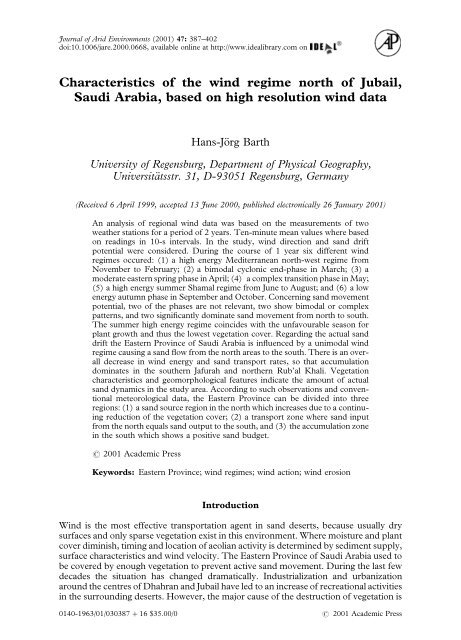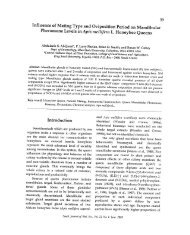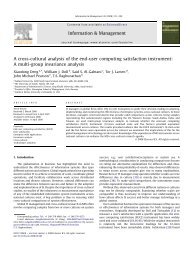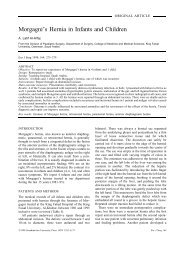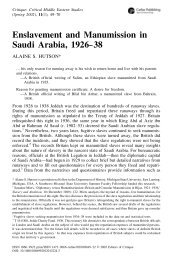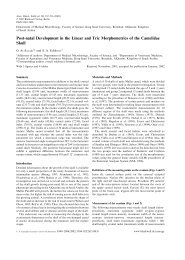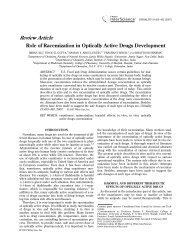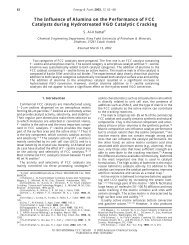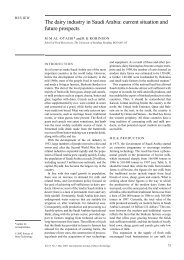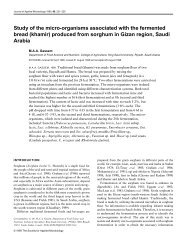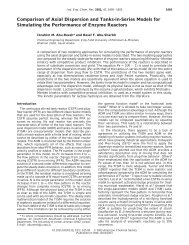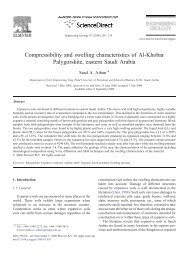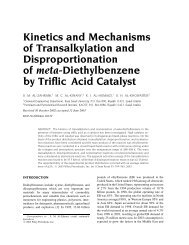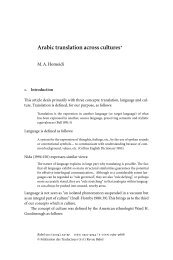Characteristics of the wind regime north of Jubail, Saudi Arabia ...
Characteristics of the wind regime north of Jubail, Saudi Arabia ...
Characteristics of the wind regime north of Jubail, Saudi Arabia ...
You also want an ePaper? Increase the reach of your titles
YUMPU automatically turns print PDFs into web optimized ePapers that Google loves.
Journal <strong>of</strong> Arid Environments (2001) 47: 387–402<br />
doi:10.1006/jare.2000.0668, available online at http://www.idealibrary.com on<br />
<strong>Characteristics</strong> <strong>of</strong> <strong>the</strong> <strong>wind</strong> <strong>regime</strong> <strong>north</strong> <strong>of</strong> <strong>Jubail</strong>,<br />
<strong>Saudi</strong> <strong>Arabia</strong>, based on high resolution <strong>wind</strong> data<br />
Hans-JoK rg Barth<br />
University <strong>of</strong> Regensburg, Department <strong>of</strong> Physical Geography,<br />
UniversitaK tsstr. 31, D-93051 Regensburg, Germany<br />
(Received 6 April 1999, accepted 13 June 2000, published electronically 26 January 2001)<br />
An analysis <strong>of</strong> regional <strong>wind</strong> data was based on <strong>the</strong> measurements <strong>of</strong> two<br />
wea<strong>the</strong>r stations for a period <strong>of</strong> 2 years. Ten-minute mean values where based<br />
on readings in 10-s intervals. In <strong>the</strong> study, <strong>wind</strong> direction and sand drift<br />
potential were considered. During <strong>the</strong> course <strong>of</strong> 1 year six different <strong>wind</strong><br />
<strong>regime</strong>s occured: (1) a high energy Mediterranean <strong>north</strong>-west <strong>regime</strong> from<br />
November to February; (2) a bimodal cyclonic end-phase in March; (3) a<br />
moderate eastern spring phase in April; (4) a complex transition phase in May;<br />
(5) a high energy summer Shamal <strong>regime</strong> from June to August; and (6) a low<br />
energy autumn phase in September and October. Concerning sand movement<br />
potential, two <strong>of</strong> <strong>the</strong> phases are not relevant, two show bimodal or complex<br />
patterns, and two significantly dominate sand movement from <strong>north</strong> to south.<br />
The summer high energy <strong>regime</strong> coincides with <strong>the</strong> unfavourable season for<br />
plant growth and thus <strong>the</strong> lowest vegetation cover. Regarding <strong>the</strong> actual sand<br />
drift <strong>the</strong> Eastern Province <strong>of</strong> <strong>Saudi</strong> <strong>Arabia</strong> is influenced by a unimodal <strong>wind</strong><br />
<strong>regime</strong> causing a sand flow from <strong>the</strong> <strong>north</strong> areas to <strong>the</strong> south. There is an overall<br />
decrease in <strong>wind</strong> energy and sand transport rates, so that accumulation<br />
dominates in <strong>the</strong> sou<strong>the</strong>rn Jafurah and nor<strong>the</strong>rn Rub’al Khali. Vegetation<br />
characteristics and geomorphological features indicate <strong>the</strong> amount <strong>of</strong> actual<br />
sand dynamics in <strong>the</strong> study area. According to such observations and conventional<br />
meteorological data, <strong>the</strong> Eastern Province can be divided into three<br />
regions: (1) a sand source region in <strong>the</strong> <strong>north</strong> which increases due to a continuing<br />
reduction <strong>of</strong> <strong>the</strong> vegetation cover; (2) a transport zone where sand input<br />
from <strong>the</strong> <strong>north</strong> equals sand output to <strong>the</strong> south, and (3) <strong>the</strong> accumulation zone<br />
in <strong>the</strong> south which shows a positive sand budget.<br />
� 2001 Academic Press<br />
Keywords: Eastern Province; <strong>wind</strong> <strong>regime</strong>s; <strong>wind</strong> action; <strong>wind</strong> erosion<br />
Introduction<br />
Wind is <strong>the</strong> most effective transportation agent in sand deserts, because usually dry<br />
surfaces and only sparse vegetation exist in this environment. Where moisture and plant<br />
cover diminish, timing and location <strong>of</strong> aeolian activity is determined by sediment supply,<br />
surface characteristics and <strong>wind</strong> velocity. The Eastern Province <strong>of</strong> <strong>Saudi</strong> <strong>Arabia</strong> used to<br />
be covered by enough vegetation to prevent active sand movement. During <strong>the</strong> last few<br />
decades <strong>the</strong> situation has changed dramatically. Industrialization and urbanization<br />
around <strong>the</strong> centres <strong>of</strong> Dhahran and <strong>Jubail</strong> have led to an increase <strong>of</strong> recreational activities<br />
in <strong>the</strong> surrounding deserts. However, <strong>the</strong> major cause <strong>of</strong> <strong>the</strong> destruction <strong>of</strong> vegetation is<br />
0140-1963/01/030387#16 $35.00/0 � 2001 Academic Press
388 H.-J. BARTH<br />
grazing because it effects even remote areas due to water trucking. Sand movement<br />
now occurs throughout <strong>the</strong> whole area. Controls on sand transport as well as estimates<br />
on potential sand movement rely on <strong>wind</strong> data. The purpose <strong>of</strong> this paper is to analyse<br />
detailed <strong>wind</strong> measurements, to characterize <strong>the</strong> <strong>wind</strong> action system <strong>of</strong> <strong>the</strong> Eastern<br />
Province throughout <strong>the</strong> course <strong>of</strong> a year, and to show that daily mean values <strong>of</strong> <strong>wind</strong><br />
speed measurements may not at all be useful to estimate <strong>the</strong> potential <strong>of</strong> sand movement<br />
in certain regions.<br />
Quantification <strong>of</strong> sand movement using methods o<strong>the</strong>r than field measurements <strong>of</strong>ten<br />
presents problems. Interactions <strong>of</strong> different variables such as grain size distribution,<br />
<strong>wind</strong> velocity, vegetation density, vegetative characteristics, <strong>wind</strong> exposure and moisture<br />
<strong>of</strong> <strong>the</strong> top soil layer determine <strong>the</strong> amount <strong>of</strong> sand which is transported. Numerous<br />
authors worked on <strong>the</strong>se problems (Marshall, 1971; Thomas, 1975; Lettau & Lettau,<br />
1978; Wasson & Nanninga, 1986; Buckley, 1987; Sarre, 1988; Hesp et al., 1989;<br />
Stockton & Gillette, 1990; Cooke et al., 1993; Lancaster, 1998). One conclusion to arise<br />
was that <strong>wind</strong> measurements as <strong>the</strong> only source <strong>of</strong> data are certainly not sufficient to<br />
estimate sand transport rates. Regarding <strong>the</strong> potential aeolian sand carrying capacity on<br />
plant-free dry surfaces we know from Bagnold’s classic paper, The physics <strong>of</strong> blown sand<br />
and desert dunes (1941), that with increasing <strong>wind</strong> speed <strong>the</strong>re is an exponential increase<br />
in potential sand movement (Fig. 1).<br />
Figure 1. With increasing <strong>wind</strong> speed <strong>the</strong>re is an exponential increase in potential sand movement<br />
(Bagnold, 1941).
CHARACTERISTICS OF A WIND REGIME 389<br />
Table 1. Monthly mean values <strong>of</strong> <strong>wind</strong> speed (m s !1 )<br />
Month Abu Kharuf Abu Ali<br />
Sep 3)9 4<br />
Oct 3)8 4<br />
Nov 5)2 6)9<br />
Dec 4)7 7)3<br />
Jan 4)8 6)4<br />
Feb 4)9 6)5<br />
Mar 4)8 5)1<br />
Apr 4)9 4)6<br />
May 4)9 5<br />
Jun 5)4 5)4<br />
Jul 6)4 5)4<br />
Aug 4)9 4)6<br />
Mean 4)9 5)4<br />
The curve shows <strong>the</strong> rate <strong>of</strong> sand movement <strong>of</strong> an average dune sand<br />
(mean"0)25 mm) in tons m !1 h !1 for <strong>wind</strong> speeds measured 1 m above ground level.<br />
The problem <strong>of</strong> using conventional meterological data for estimating potential sand<br />
carrying capacity in a practical way is <strong>the</strong> low resolution <strong>of</strong> <strong>wind</strong> measurements. Usually<br />
mean values are registered (daily or hourly), but monthly mean values <strong>of</strong> <strong>wind</strong> speed are<br />
totally useless for any estimates <strong>of</strong> sand movement. Example, at <strong>the</strong> Abu Kharuf station<br />
<strong>the</strong>re is an average <strong>wind</strong> speed <strong>of</strong> 3)8ms !1 (10 m above ground level) in October<br />
(Table 1). This suggests <strong>the</strong>re was no sand movement at all, because this value is below<br />
<strong>the</strong> threshold velocity (at which sand movement is initiated) <strong>of</strong> about 6 m s !1 . But in<br />
fact <strong>the</strong>re were 19 days where <strong>wind</strong> speeds significantly exceeded <strong>the</strong> threshold velocity<br />
(see Fig. 2).<br />
Figure 2. Autumn situation with regular diurnal pattern and low energy.
390 H.-J. BARTH<br />
Analysis <strong>of</strong> high resolution <strong>wind</strong> data provided by two wea<strong>the</strong>r stations<br />
<strong>north</strong> <strong>of</strong> <strong>Jubail</strong><br />
The two automatic climatological recording stations (Thies CLIMA, GoK ttingen,<br />
Germany) are located at <strong>the</strong> eastern tip <strong>of</strong> Abu Ali Island representing a marine climate<br />
(27318�03�N and 49341�57�E) and at Jebel Abu Kharuf (27322�26�N and 49310�21�E),<br />
an inland area 5 km from <strong>the</strong> coast line. Because <strong>the</strong> main <strong>wind</strong> direction is <strong>north</strong> to<br />
<strong>north</strong>-west <strong>the</strong> air masses already pass over 50 to 60 km <strong>of</strong> terrestrial area before <strong>the</strong>y<br />
reach <strong>the</strong> station on Abu Kharuf, and <strong>the</strong>refore represent a coastal terrestrial climate<br />
(Fig. 3). In <strong>the</strong> following explanations only <strong>the</strong> data recorded at Abu Kharuf is<br />
considered.<br />
Data was recorded from September 1993 until November 1995. Wind speed and<br />
direction was recorded every 10 s. The data logger (Thies DL15) was powered by<br />
a 12 V battery. For data transmission a memory card (256 K) was used. The fact that<br />
data could only be collected every 3 weeks (due to remote locations and lack <strong>of</strong><br />
personnel) and limitations <strong>of</strong> <strong>the</strong> memory card’s storage capacity meant it was not<br />
possible to record <strong>the</strong> 10-s values. Every 10 min a mean value was calculated automatically<br />
based on <strong>the</strong> measurements that were made every 10 s. Even <strong>the</strong> 10-min mean<br />
values did not represent data for exact estimations concerning <strong>the</strong> potential sand<br />
carrying capacity because highly effective high-speed gusts are smoo<strong>the</strong>d into lower<br />
speed mean values. But this was still sufficient to show <strong>the</strong> large-scale characteristics<br />
<strong>of</strong> <strong>the</strong> Eastern <strong>Arabia</strong>n coastal <strong>wind</strong> <strong>regime</strong>.<br />
Figures 3}5 show that <strong>the</strong> <strong>wind</strong> velocities mostly display a diurnal pattern with calm<br />
<strong>wind</strong>s at night and maximum values during midday or afternoon. This is a typical<br />
characteristic <strong>of</strong> desert <strong>wind</strong>s. At night cooling creates a stable surface layer. The<br />
temperature inversion prevents vertical air exchange. As <strong>the</strong> sun rises convection<br />
disturbs <strong>the</strong> inversion, probably supported by gravity waves at <strong>the</strong> surface <strong>of</strong> <strong>the</strong><br />
inversion (Warren & Knott, 1983). The unstable atmosphere promotes turbulent<br />
vertical air exchange bringing high velocity upper <strong>wind</strong>s down to <strong>the</strong> surface. Wind<br />
speeds usually continue to increase until <strong>the</strong> afternoon, driven largely by convection.<br />
Figure 3 represents a typical autumn situation with a very regular diurnal pattern<br />
beginning with almost complete calm in <strong>the</strong> early morning and culminating in <strong>the</strong><br />
afternoon to <strong>wind</strong> speeds between 5 and 9 m s !1 . Figure 4 represents a winter <strong>regime</strong>.<br />
Mediterranean depression generally provide a higher <strong>wind</strong> speed, higher variability and<br />
days when <strong>wind</strong> velocity never drops below 6 m s !1 . Figure 5 represents <strong>the</strong> Shamal<br />
Figure 3. Location <strong>of</strong> wea<strong>the</strong>r stations.
CHARACTERISTICS OF A WIND REGIME 391<br />
Figure 4. Winter <strong>regime</strong> with higher variability and energy.<br />
time in early summer with strong and hot nor<strong>the</strong>rly <strong>wind</strong>s exceeding 15 m s !1 during<br />
midday, abating at dawn and sometimes coming to a complete rest.<br />
On <strong>the</strong> basis <strong>of</strong> <strong>the</strong> 10-min mean values, four <strong>wind</strong> classes in <strong>the</strong> efficient velocity<br />
range were created. Low <strong>wind</strong>s not able to transport sand (potentially) were not<br />
considered. Class 1 covers <strong>the</strong> range between 6}9 ms !1 (mean"7)5ms !1 ), class<br />
2 covers 9}12 m s !1 (mean"10)5 ms !1 ), class 3 covers 12}15 m s !1 (mean"<br />
13)5ms !1 ) and class 4 covers 15}18 m s !1 (mean"16)5ms !1 ). For each month <strong>the</strong><br />
Figure 5. Summer <strong>regime</strong> with regular diurnal pattern and high energy.
392 H.-J. BARTH<br />
Month<br />
Table 2. Potential sand movement at Abu Kharuf in 1993/94<br />
Wind speed<br />
class (m sec !1 )<br />
Hours<br />
blowing<br />
Potential sand<br />
movement<br />
(t m !1 )<br />
Total<br />
potential sand<br />
movement (t m !1 )<br />
November 7)5 149 0)23<br />
10)5 52)8 1)23<br />
13)5 9)2 0)92<br />
16)5 0)8 0)21 2'59<br />
December 7)5 106)8 0)16<br />
10)5 8)5 0)21 0'37<br />
January 7)5 179)7 0)28<br />
10)5 27)2 0)66<br />
13)5 4)8 0)48 1'42<br />
February 7)5 148)7 0)23<br />
10)5 27)4 0)67<br />
13)5 3)8 0)38<br />
16)5 0)5 0)13 1'41<br />
March 7)5 73)6 0)11<br />
10)5 41)8 1)02<br />
13)5 9)6 0)96<br />
16)5 0)5 0)13 2)22<br />
April 7)5 135)9 0)21<br />
10)5 38)4 0)94<br />
13)5 3)4 0)34<br />
16)5 0)2 0)05 1'54<br />
May 7)5 125)5 0)19<br />
10)5 39)2 0)96<br />
13)5 12 1)21<br />
16)5 2)2 0)53 2'89<br />
June 7)5 104)1 0)16<br />
10)5 55)7 1)36<br />
13)5 12)3 1)26 2'78<br />
July 7)5 151)7 0)23<br />
10)5 46)8 1)14<br />
13)5 4)3 0)43<br />
16)5 0)2 0)05 1'85<br />
August 7)5 130)6 0)2<br />
10)5 53)1 1)3<br />
13)5 4)8 0)48 1'98<br />
September 7)5 24)3 0)04 0'04<br />
October 7)5 96 0)15<br />
10)5 1)4 0)03 0'18<br />
time period that a certain velocity range persisted was summed (Table 2). On <strong>the</strong> basis<br />
<strong>of</strong> <strong>the</strong> sand transport equation after Bagnold (1941) <strong>the</strong> potential sand movement<br />
capacity <strong>of</strong> each <strong>wind</strong> class was calculated in tons m��.
CHARACTERISTICS OF A WIND REGIME 393<br />
The data show that a high proportion <strong>of</strong> sand can be moved by strong <strong>wind</strong>s with low<br />
frequency (Fig. 6), i.e. 49)5% <strong>of</strong> sand can be moved by <strong>wind</strong>s blowing only during 4)5%<br />
<strong>of</strong> <strong>the</strong> year. Winds blowing during only 0)73% <strong>of</strong> <strong>the</strong> year can move 33)6% <strong>of</strong> <strong>the</strong> sand,<br />
and <strong>wind</strong>s blowing only 0)05% <strong>of</strong> <strong>the</strong> year or 4)4 h can move 5)7% <strong>of</strong> <strong>the</strong> total sand.<br />
So far <strong>wind</strong> direction has not been considered. According to <strong>the</strong> classification <strong>of</strong><br />
sand-moving <strong>wind</strong> systems by Fryberger & Dean (1979), <strong>the</strong>re is a wide unimodal <strong>wind</strong><br />
<strong>regime</strong> with intermediate energy in <strong>the</strong> <strong>Jubail</strong> area. By analysis <strong>of</strong> <strong>wind</strong> speed and<br />
direction over a 2-year period, 1 year can be divided into six different <strong>wind</strong> phases.<br />
In <strong>the</strong> following section each phase is shortly described and illustrated by <strong>wind</strong> roses and<br />
magnitude-frequency relationships after Lancaster (1985).<br />
High energy Mediterranean <strong>north</strong>-west <strong>regime</strong><br />
In November, December, January, and February Mediterranean depressions usually<br />
reach <strong>the</strong> nor<strong>the</strong>rn <strong>Arabia</strong>n Peninsula and cause <strong>north</strong>-westerly <strong>wind</strong>s accompanied by<br />
some precipitation, depending on how fast <strong>the</strong> <strong>wind</strong>s passed over <strong>the</strong> Mediterranean<br />
Sea. South-easterly <strong>wind</strong>s probably result in currents on <strong>the</strong> south-eastern flank <strong>of</strong> <strong>the</strong><br />
continental Asian high pressure cell (Fig. 7).<br />
Bimodal cyclonic end phase<br />
In March <strong>the</strong> appearance <strong>of</strong> Mediterranean depressions significantly decreases due to<br />
<strong>the</strong>ir poleward retreat. Easterly <strong>wind</strong>s usually result in regional <strong>the</strong>rmal action caused by<br />
land}sea pressure differences and mark <strong>the</strong> end <strong>of</strong> <strong>the</strong> cyclonic activity (Fig. 8).<br />
Moderate eastern spring phase<br />
In April <strong>the</strong> inter regional pressure differences are low. The continental Asian low is<br />
poorly developed and differs little from <strong>the</strong> tropical low. The North African high is<br />
also not yet established. Easterly <strong>wind</strong>s result in <strong>the</strong>rmal action caused by land}sea<br />
pressure differences (Fig. 9).<br />
Figure 6. Magnitude frequency relationship between sand movement and <strong>wind</strong>speed<br />
(1993/94).
394 H.-J. BARTH<br />
Figure 7. Magnitude frequency relationship and <strong>wind</strong> rose diagrams for November, December,<br />
January and February.<br />
Complex transition phase<br />
May marks a transition between <strong>the</strong> low and mostly <strong>the</strong>rmal <strong>wind</strong> action in spring and<br />
<strong>the</strong> Shamal typical for <strong>the</strong> summer months. Wind directions are complex during this<br />
phase but velocities are generally high (Fig. 10).
CHARACTERISTICS OF A WIND REGIME 395<br />
Figure 8. Magnitude frequency relationship and <strong>wind</strong> rose diagrams for March.<br />
Figure 9. Magnitude frequency relationship and <strong>wind</strong> rose diagrams for April.<br />
Figure 10. Magnitude frequency relationship and <strong>wind</strong> rose diagrams for May.
396 H.-J. BARTH<br />
High energy summer Shamal <strong>regime</strong><br />
During June, July and August <strong>the</strong>re are unimodal strong <strong>north</strong> to <strong>north</strong>-easterly <strong>wind</strong>s<br />
supported by two pressure zones. First, <strong>the</strong> continental Asian low pressure cell is fully<br />
established and reaches from <strong>the</strong> Indian subcontinent into <strong>the</strong> <strong>Arabia</strong>n Gulf. It provides<br />
a nor<strong>the</strong>rly current on its western flank. Second, <strong>the</strong> eastern North African high pressure<br />
cell supports nor<strong>the</strong>rly <strong>wind</strong>s in <strong>the</strong> area <strong>of</strong> <strong>the</strong> <strong>Arabia</strong>n Peninsula because <strong>of</strong> its<br />
clockwise direction. Compared to <strong>the</strong> rest <strong>of</strong> <strong>the</strong> year stronger <strong>wind</strong>s between<br />
9}12 m s !1 are especially significant (Fig. 11).<br />
Figure 11. Magnitude frequency relationship and <strong>wind</strong> rose diagrams for June, July and August.
CHARACTERISTICS OF A WIND REGIME 397<br />
Low energy autumn phase<br />
In September and October <strong>the</strong> Asian low pressure cell decreases considerably. At <strong>the</strong><br />
same time <strong>the</strong> North African high retreats back over <strong>the</strong> Libyan desert whereby <strong>the</strong><br />
pressure gradients decline and <strong>the</strong>refore variable low energy <strong>wind</strong>s are characteristic for<br />
<strong>the</strong> Eastern Province. Due to <strong>the</strong> high temperatures <strong>of</strong> <strong>the</strong> Gulf <strong>the</strong>re are no significant<br />
<strong>the</strong>rmal <strong>wind</strong>s during this time <strong>of</strong> <strong>the</strong> year (Fig. 12).<br />
These observations lead to <strong>the</strong> following results concerning potential <strong>wind</strong> action in<br />
<strong>the</strong> central coastal lowlands <strong>of</strong> <strong>the</strong> Eastern Province in <strong>Saudi</strong> <strong>Arabia</strong>:<br />
(1) The total sand drift capacity applying Bagnold’s calculation and high resolution<br />
<strong>wind</strong> data described above is about 19)3 tons m !1 y !1 . Calculations on <strong>the</strong> basis<br />
<strong>of</strong> daily mean values lead to a much lower result <strong>of</strong> 2)1 tons m !1 y !1 . Thus,<br />
concerning sand drift potential one formula may lead to considerably higher<br />
results when higher resolution <strong>wind</strong> data is used.<br />
(2) Concerning <strong>wind</strong> erosion, <strong>the</strong> most effective times <strong>of</strong> <strong>the</strong> year are <strong>the</strong> high<br />
energy Mediterranean <strong>north</strong>-west <strong>regime</strong> from December until February and <strong>the</strong><br />
Figure 12. Magnitude frequency relationship and <strong>wind</strong> rose diagrams for September and October.
398 H.-J. BARTH<br />
high energy summer Shamal <strong>regime</strong> from June until August. The latter period<br />
coincides with <strong>the</strong> unfavourable season for plant growth and thus <strong>the</strong> lowest<br />
vegetation cover. This makes <strong>the</strong> summer season <strong>the</strong> most important time in <strong>the</strong><br />
degradation process, which is intensified when animals are kept on <strong>the</strong> ranges<br />
during this time.<br />
(3) The effective sand drift direction is SSE. There is a potential loss <strong>of</strong> sand in<br />
this direction which makes <strong>the</strong> region a potential sand source.<br />
Current situation in <strong>the</strong> area<br />
Major grazing activity during <strong>the</strong> last few decades and a continuously increasing animal<br />
population accompanied by supplemental feeding and trucking <strong>of</strong> water have changed<br />
<strong>the</strong> vegetation significantly (Barth, 1998b, 1999). Former extensive shrubland communities<br />
such as Rhanterium epapposi (Mandaville, 1990) covering 15}20% <strong>of</strong> <strong>the</strong> ground<br />
have become degraded Panicum grasslands which seldom exceed a ground cover <strong>of</strong><br />
more than 5% (Barth, 1998b). The ratio <strong>of</strong> biomass production between perennials and<br />
annuals is 1: 4 in <strong>the</strong> heavily grazed areas compared to 2:1 in fenced areas with minor<br />
grazing activity (detailed descriptions <strong>of</strong> signs and <strong>the</strong> state <strong>of</strong> degradation is given in<br />
Barth, 1998a, 1999). This indicates that <strong>the</strong> rangeland ecosystems are disturbed to<br />
a high degree. The reduction in vegetation cover reduced <strong>the</strong> most effective<br />
protection against aeolian erosion, a process which has become common in this area.<br />
Active sand dynamics are indicated by sand ripples, lag deposits and exposed root<br />
systems, which are common in most vegetation types. The reactivation <strong>of</strong> previously<br />
stabilized dunes can be observed on severely damaged spots. Hence, grazing pressure is<br />
much higher than <strong>the</strong> ecological capacity <strong>of</strong> <strong>the</strong> rangelands. Ano<strong>the</strong>r important fact is<br />
that animals are continuously kept on <strong>the</strong> range. This practice intensifies degradation,<br />
especially during <strong>the</strong> summer months when plant production is at a minimum and <strong>the</strong><br />
<strong>wind</strong> energy for aeolian erosion is at its maximum. This combination accelerates<br />
<strong>the</strong> whole process <strong>of</strong> degradation and is <strong>the</strong> major cause <strong>of</strong> <strong>the</strong> region’s change into an<br />
active sand source region with a negative sediment balance.<br />
Model <strong>of</strong> <strong>wind</strong> action in <strong>the</strong> Eastern Province<br />
In <strong>the</strong> Eastern Province <strong>of</strong> <strong>Saudi</strong> <strong>Arabia</strong> <strong>the</strong> nor<strong>the</strong>rn areas are linked to <strong>the</strong> nor<strong>the</strong>rn<br />
Rub’al Khali in <strong>the</strong> south by <strong>the</strong> constant flow <strong>of</strong> a regional <strong>wind</strong> action system (WAS).<br />
This provides continuous sand transport along <strong>the</strong> main <strong>wind</strong> direction (Fig. 13). The<br />
three distinct regions <strong>of</strong> <strong>wind</strong> action were briefly described by Oguz et al. (1998). In <strong>the</strong><br />
nor<strong>the</strong>rn coastal lowlands and <strong>the</strong> gravel plains <strong>of</strong> Wadi Al Batin high <strong>wind</strong> speeds occur<br />
throughout <strong>the</strong> year (resultant drift direction is shown on Fig. 13), but no active aeolian<br />
erosion can be observed. This is because in <strong>the</strong> gravel plains no erodible material is left<br />
and in <strong>the</strong> coastal lowlands a dense vegetation cover prevents erosion <strong>of</strong> <strong>the</strong> sand sheets.<br />
It is <strong>the</strong>refore a region with a potential negative sand budget (A1 in Fig. 14). In <strong>the</strong> South<br />
<strong>of</strong> this region is <strong>the</strong> study area dominated by landforms typical for active <strong>wind</strong> erosion,<br />
such as parabolic dunes, longitudinal dune stripes, sand sheets, nabkhas, giant ripples,<br />
exposed roots on perennial vegetation, and sabkhas (Barth, 1998a, 1999). Here <strong>the</strong>re is<br />
definitely a negative sand budget (A2). In this area <strong>the</strong> vegetation cover was reduced to<br />
a degree which allows <strong>wind</strong> erosion and sand movement in a sou<strong>the</strong>rly direction<br />
according to <strong>the</strong> main direction in <strong>the</strong> unimodal <strong>wind</strong> <strong>regime</strong>. Fur<strong>the</strong>r south (around <strong>the</strong><br />
area <strong>of</strong> Dhahran) barchanoid dunes and young sand sheets (Fryberger et al., 1984) are<br />
typical <strong>of</strong> a transport zone and relatively balanced sand budget. Here (B in Fig. 14) sand<br />
erosion and movement to <strong>the</strong> south equals sand input from <strong>the</strong> <strong>north</strong>. Decreasing <strong>wind</strong><br />
speeds to <strong>the</strong> south cause sand accumulation which is represented mainly by transverse
CHARACTERISTICS OF A WIND REGIME 399<br />
Figure 13. Sand transport direction in <strong>the</strong> Eastern Province <strong>of</strong> <strong>Saudi</strong> <strong>Arabia</strong>.<br />
chains (Mainguet & Dumay, 1998). In this area in <strong>the</strong> sou<strong>the</strong>rn Jafurah and nor<strong>the</strong>rn<br />
Rub’al Khali <strong>the</strong> sediment balance is positive (C in Fig. 14). Studies by Anton (1983) in<br />
<strong>the</strong> Eastern Province show that <strong>the</strong> dunes <strong>of</strong> <strong>the</strong> Jafurah desert (south <strong>of</strong> Dhahran) do<br />
not seem to be more than 4000 years old and <strong>the</strong> result <strong>of</strong> a major change in <strong>the</strong> sand<br />
dynamics <strong>of</strong> <strong>the</strong> nor<strong>the</strong>rn regions. This could have been triggered by large scale<br />
aridification which started around 5500 B.P. (Sirocko, 1996), followed by degradation<br />
<strong>of</strong> <strong>the</strong> nor<strong>the</strong>rn areas. Anton (1983) also believes that <strong>the</strong>re is a change in grain size in<br />
<strong>the</strong> dune sands from larger grains in <strong>the</strong> <strong>north</strong> to smaller grains in <strong>the</strong> south. This could<br />
be typical for long distance sand movement (Mainguet & Chemin, 1991). In Fig. 14 <strong>the</strong><br />
generalized borders between <strong>the</strong> different sand budget zones were determined by<br />
satellite image analysis and field observations. They should, <strong>the</strong>refore, be considered as<br />
transition zones ra<strong>the</strong>r than precise sand budget divides.<br />
Conclusion<br />
During <strong>the</strong> course <strong>of</strong> one year six different <strong>wind</strong> <strong>regime</strong>s occur. These are:<br />
(1) a high energy Mediterranean <strong>north</strong>-west <strong>regime</strong> from November to February;<br />
(2) a bimodal cyclonic end phase in March;
400 H.-J. BARTH<br />
Figure 14. Transport zones and sand budgets in <strong>the</strong> Eastern Province <strong>of</strong> <strong>Saudi</strong> <strong>Arabia</strong>. Dune<br />
type location sources: field observation, satellite images, Breed et al. (1979).<br />
(3) a moderate eastern spring phase in April;<br />
(4) a complex transition phase in May;<br />
(5) a high energy summer Shamal <strong>regime</strong> from June to August; and<br />
(6) a low energy autumn phase in September and October.<br />
Two phases (high energy summer <strong>regime</strong> and high energy Mediterranean <strong>north</strong>-west<br />
<strong>regime</strong>) significantly dominate sand movement from <strong>north</strong> to south. The summer high<br />
energy <strong>regime</strong> coincides with <strong>the</strong> unfavourable season for plant growth and thus <strong>the</strong><br />
lowest vegetation cover.<br />
Predictions <strong>of</strong> sand transport rates are subject to numerous uncertainties and remain<br />
qualitative estimates, but <strong>the</strong>re is no question that low-frequency, high-magnitude <strong>wind</strong><br />
events are effective in transporting sand in <strong>the</strong> eastern <strong>Arabia</strong>n Peninsula. To<br />
estimate <strong>the</strong> potential sand movement when conventional meteorological data is used it<br />
is necessary to register <strong>the</strong> unsteadiness (gustiness) <strong>of</strong> <strong>the</strong> <strong>wind</strong>. The more generalized<br />
data is used for transport estimations, <strong>the</strong> less accurate are <strong>the</strong> achieved results.<br />
In <strong>the</strong> Eastern Province <strong>of</strong> <strong>Saudi</strong> <strong>Arabia</strong> increasing human activity and overgrazing<br />
have reduced <strong>the</strong> vegetation cover within <strong>the</strong> area <strong>of</strong> potential negative sand<br />
balance (A1). Sand sheets and stabilized dunes, stripped <strong>of</strong> <strong>the</strong> protecting cover,<br />
become active and are now exposed to <strong>wind</strong> erosion (A2). Areas <strong>of</strong> potential negative<br />
sand balance are currently becoming areas <strong>of</strong> actual negative sand budget caused by land<br />
degradation and <strong>wind</strong> erosion. By this process <strong>the</strong> transition zone between A2 and A1<br />
moves <strong>north</strong>wards. This dynamic with a potential negative balance becoming an actual<br />
negative balance is <strong>the</strong> most significant feature <strong>of</strong> ongoing land degradation in this<br />
region.
CHARACTERISTICS OF A WIND REGIME 401<br />
I am grateful to NCWCD, Riyadh for making this study possible. Many thanks to our project<br />
manager Dr F. Krupp. Assistance, continuous help and co-operation both in <strong>the</strong> field and <strong>the</strong><br />
laboratory was provided by numerous individuals.<br />
References<br />
Anton, D. (1983) Modern eolian deposits <strong>of</strong> <strong>the</strong> Eastern Province <strong>of</strong> <strong>Saudi</strong> <strong>Arabia</strong>. In: Brookfield,<br />
M.E. & Ahlbrandt, T.S. (Eds), Eolian Sediments and Processes. Developments in Sedimentology,<br />
38: 365}378.<br />
Bagnold, R.A. (1941). The Physics <strong>of</strong> Blown Sand and Desert Dunes. London: Chapman and Hall.<br />
Barth, H.-J. (1999). Desertification in <strong>the</strong> Eastern Province <strong>of</strong> <strong>Saudi</strong> <strong>Arabia</strong>. Journal <strong>of</strong> Arid<br />
Environments, 43: 399}410.<br />
Barth, H.-J. (1998a). Sebkhas als Ausdruck von Landschaftsdegradation in den zentralen KuK stentieflaK<br />
ndern der Ostprovinz <strong>Saudi</strong> Arabiens. Dissertation an der Ruhr-UniversitaK t-Bochum,<br />
Regensburger Geographische Schriften, Bd. 29, Regensburg.<br />
Barth, H.-J. (1998b) Status <strong>of</strong> vegetation and an assessment <strong>of</strong> <strong>the</strong> impact <strong>of</strong> overgrazing in an area<br />
<strong>north</strong> <strong>of</strong> <strong>Jubail</strong>, <strong>Saudi</strong> <strong>Arabia</strong>. In: Omar, S.A.S., Misak, R., Al-Ajmi, D. & Al-Awadhi, N. (Eds),<br />
Sustainable Development in Arid Zones, Vol. 2, pp. 435}450, Rotterdam.<br />
Breed, C.S., Fryberger, S.G., Andrews, S., McCauley, C., Lennartz, F., Gebel, D. & Horstman,<br />
K. (1979). Regional studies <strong>of</strong> sand seas, using Landsat (ERST) imagery. In: McKee, E.D.<br />
(Ed.), A study <strong>of</strong> global sand seas. USGS Pr<strong>of</strong>essional Paper, 1052: 305}381.<br />
Buckley, R.C. (1987). The effect <strong>of</strong> sparse vegetation on <strong>the</strong> transport <strong>of</strong> Dune sand by<br />
Wind. Nature, 325: 426}428.<br />
Cooke, R., Warren, A. & Goudie, A. (1993). Desert Geomorphology. London: UCL.<br />
Fryberger, S.G. & Dean, G. (1979). Dune forms and <strong>wind</strong> <strong>regime</strong>. In: McKee, E.D. (Ed.),<br />
A study <strong>of</strong> global sand seas. USGS Pr<strong>of</strong>essional Paper, 1052: 137}170.<br />
Fryberger, S.G., Al-Sari, A.M., Clisham, T.J., Rizvi, S.A.R. & Al-Hinai, K.G. (1984). Wind<br />
sedimentation in <strong>the</strong> Jafurah sand sea, <strong>Saudi</strong> <strong>Arabia</strong>. Sedimentology, 31: 413}431.<br />
Hesp, P.A., Hyde, R., Hesp, V. & Zhengyu, Q. (1989). Longitudinal dunes can move sideways.<br />
Earth Surface Processes and Landforms, 14: 447}452.<br />
Lancaster, N. (1985). Winds and sand movements in <strong>the</strong> Namib Sand Sea. Earth Surface Processes<br />
and Landforms, 10: 607}619.<br />
Lancaster, N. (1998). Understanding <strong>the</strong> dynamics <strong>of</strong> aeolian sand transport systems - an<br />
overview <strong>of</strong> recent progress. In: Omar, S.A.S., Misak, R., Al-Ajmi, D. & Al-Awadhi, N. (Eds),<br />
Sustainable Development in Arid Zones, Vol 1, pp. 111}126, Rotterdam.<br />
Lettau, K. & Lettau, H.H. (1978). Experimental and micro-meteorological field studies on dune<br />
migration. Lettau, H.H & Lettau, K. (Eds), Exploring <strong>the</strong> World’s Driest Climate. pp. 110}147.<br />
University <strong>of</strong> Wisconsin, Madison, Institute for Environmental Studies.<br />
Mainguet, M. & Chemin, M.C. (1991). Wind degradation on <strong>the</strong> sandy soils <strong>of</strong> <strong>the</strong> Sahel <strong>of</strong> Mali<br />
and Niger and its parts in Desertification. Acta Mechanica, Suppl. 2: 113}130.<br />
Mainguet, M. & Dumay, F. (1998). The concepts <strong>of</strong> global <strong>wind</strong> action system and sediment balance,<br />
keys for aeolian action and aesertification monitoring. Omar, S.A.S., Misak, R., Al-Ajmi, D.<br />
& Al-Awadhi, N. (Eds), Sustainable Development in Arid Zones, Vol.1,pp.127}141, Rotterdam.<br />
Mandaville, J.P. (1990). Flora <strong>of</strong> Eastern <strong>Saudi</strong> <strong>Arabia</strong>. London. 482 pp.<br />
Marshall, J.K. (1971). Drag measurements in roughness arrays <strong>of</strong> varying densities and distribution.<br />
Agricultural Meteorology, 8: 269}292.<br />
Oguz, I., Khattab, G. Al-Hinai, Wasim, A. & Ali, A.Z. (1998). Desert geomorphology. Eolian<br />
sand drift rates, and <strong>the</strong>ir role in design <strong>of</strong> sand control measures in <strong>the</strong> Abqaiq area. <strong>Saudi</strong><br />
<strong>Arabia</strong>. Omar, S.A.S., Misak, R., Al-Ajmi, D. & Al-Awadhi, N. (Eds), Sustainable Development<br />
in Arid Zones, Vol. 1, pp. 213}221, Rotterdam.<br />
Sarre, R.D. (1988). The morphological significance <strong>of</strong> vegetation and relief on coastal foredune<br />
processes. Zeitschrift fuK r Geomorphologie. Supplementband, 73: 17}31.<br />
Sirocko, F. (1996). The evolution <strong>of</strong> <strong>the</strong> Monsoon Climate over <strong>the</strong> <strong>Arabia</strong>n Sea during <strong>the</strong> last<br />
24 000 Years. K. Heine (Ed.), Palaeoecology <strong>of</strong> Africa, 24: 53}70.<br />
Stockton, P.H. & Gillette, D.A. (1990). Field measurements <strong>of</strong> <strong>the</strong> sheltering effect <strong>of</strong><br />
vegetation on erodible land surfaces. Land Degradation and Rehabilitation, 2: 77}86.<br />
Thomas, Y.-F. (1975). Actions eHoliennes en milieu littoral } la Pointe de la Courbe, MeH moires de la<br />
Laboratoire de GeH omorphologie de l’ED cole des Hautes ED tudes 29.
402 H.-J. BARTH<br />
Warren, A. & Knott, P. (1983). Desert dunes: a short review <strong>of</strong> needs in desert dune research and<br />
a recent study <strong>of</strong> micrometeorological dune-initiation mechanisms. Brookfield, M.E. &<br />
Ahlbrandt, T. S. (Eds), Eolian sediments and processes. Amsterdam: Elsevier.<br />
Wasson, R.J. & Nanninga, P.M. (1986). Estimating <strong>wind</strong> transport <strong>of</strong> sand on vegetated surfaces.<br />
Earth Surface Processes and Landforms, 11: 505}514.


